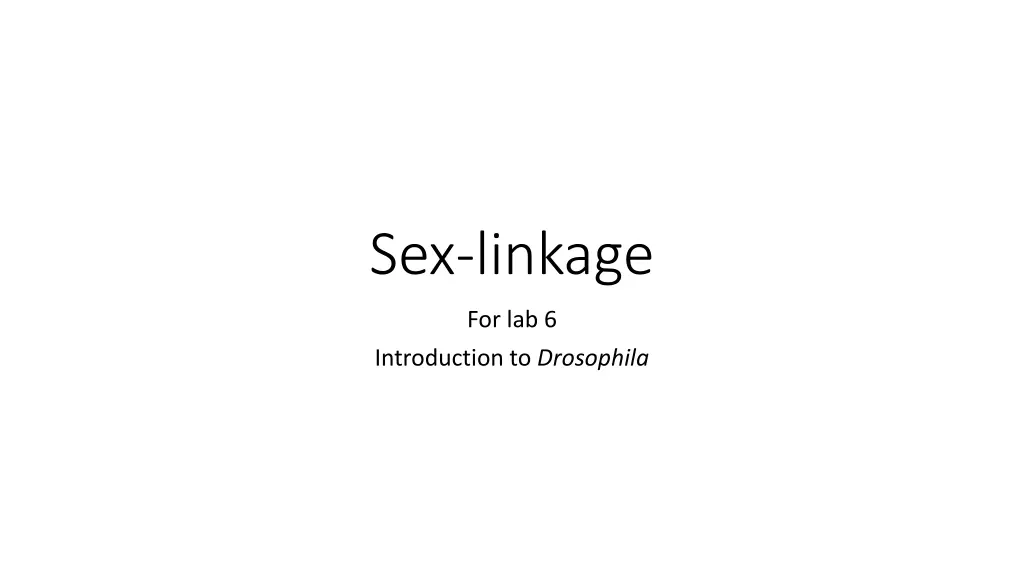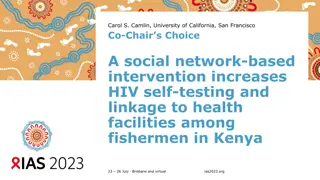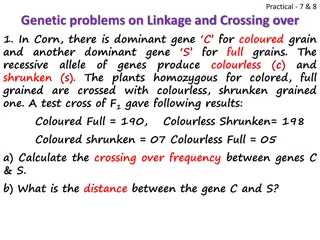
Understanding Sex Determination: Insights from Drosophila and Humans
Explore the fascinating world of sex determination through the lens of Drosophila and humans. From the basics of sex chromosomes to genetic disorders, delve into the similarities and differences in sex-linked genes. Discover why the Y chromosome shares sequence similarity with the X chromosome and unravel the complexity of sex determination mechanisms.
Download Presentation

Please find below an Image/Link to download the presentation.
The content on the website is provided AS IS for your information and personal use only. It may not be sold, licensed, or shared on other websites without obtaining consent from the author. If you encounter any issues during the download, it is possible that the publisher has removed the file from their server.
You are allowed to download the files provided on this website for personal or commercial use, subject to the condition that they are used lawfully. All files are the property of their respective owners.
The content on the website is provided AS IS for your information and personal use only. It may not be sold, licensed, or shared on other websites without obtaining consent from the author.
E N D
Presentation Transcript
Sex-linkage For lab 6 Introduction to Drosophila
Moving into Chapter 4 We will begin to think about extensions to what Mendel saw in his pea plant studies. Starting with section 4.11 to help us with our Drosophila lab. (starting p. 87) Section 4.11 has us consider, that unlike many plants, most sexually reproducing animals show clear-cut sexes---male and female, but not both in the same organism. Sex (male or female) determination is of course, determined by specific genes.
Chapter 7 covers sex determination and we will read some of chapter 7 For some organisms we refer to the chromosomes that carry the genes for sex determination (during development) as sex chromosomes. All other chromosomes having no genes for sex determination are called autosomes. Humans have 22 autosomes, and 2 sex chromosomes, X and Y. Males have 1 X and 1Y Females have 2 X chromosomes
In humans, Y chromosome determines maleness. How do we know?... A number of syndromes result from meiotic non-disjunction giving various numbers of X and Y in offspring. (45, X) ---Turner syndrome (develops as female) (47, XXY) Kleinfelter syndrome (develops male) Presence of Y, defines maleness even if the person has XX.
Drosophila also has X and Y chromosomes. XX female XY ---Male (slightly different way of determining sex)
Back to humanslets compare X and Y X large and important!! Encodes 1,098 genes Y smaller (less important?...) Encodes 78 genes.
Electron micrograph Y-chromosome X-chromosome
Scientifically verified Some suspected Y-linked genes
Y-chromosome (The real Y) 2 main regions --- MSY male specific region PAR pseudoautosomal region (small region with homology (sequence similarity) to X (SEE chapter 7! Section 7.3-7.4)
Thinker question---Why would the Y chromosome have to have some sequence similarity (homology) to X? Figure 7.9
PAR facilitates the necessary alignment of X and Y during meiosis Each gamete receives X or Y from male in sperm, one X from female in eggs. Fertilization of egg (carrying X) by sperm (carrying X or Y) will create XX female zygote, or XY male zygote. Male determines the sex of the child
X and Y are not true homologs (Although they do pair in meiosis) Must consider the difference in males and females in terms of X and Y-linked genes
Females----homogametic sex. 2 copies of every gene located on X chromosome. (similar to autosomes) No genes from Y chromosome X X
Males----heterogametic sex. One copy of genes located on X, one copy of genes located on Y---can be nethier homozygous or heterozygous for X or Y linked genes----instead HEMIZYGOUS. X Y
Practice the pedigree for sex determination Just show males and females and how they can inherit their sex chromosomes. Every female gets one of her mother s X chromosomes and her father s only X chromosome. Every male gets one his mother s X chromosomes and his fathers Y chromosome.
What are sex-linked traits? (traits controlled by genes located on sex chromosomes X or Y) Start with a rare Y-linked trait. (So few genes on Y that these traits are rarely noted.) hairy ear trait has been mapped to a gene on the Y chromosome. On board
Be careful interpreting pedigrees. Is it true that a Y- linked trait pedigree will show every male shaded? affected? Are females ever affected? Are Y-linked traits truly dominant or recessive? Can they skip a generation and reappear?
X-linked traits Much more common than Y-linked traits (many more genes on X) First recognized in Drosophila by Thomas Morgan Noted that the white eye trait was inherited in a sex-linked way---concluded that the white mutation was in a gene on the X-chromosome
To study, you must track both the trait and the sex of the organism showing the trait. Let s review Drosophila eye color. White eyes is a recessive trait. The dominant color is red. The inheritance of white eyes looks different from the autosomal recessive traits we ve seen so far---depending on how the cross is setup.
Unlike Mendel, Morgan noted differences in reciprocal crosses F1 shows both parental traits 3:1 but only males have white eyes F2 shows 1:1 ratio Figure 4.12
Morgan proposed, that the gene controlling eye color was sex-linked. The fact that only males had white eyes in the F1 of cross A suggested X-linked. He tried the following scheme to explain the unexpected pattern of inheritance.
The hypothesis that the w (white) allele was located on the X chromosome, is consistent with patterns of inheritance in both reciprocal crosses. All 3 mutations you noticed today are in genes located on the X- chromosome. They are X-linked recessive traits, controlled by X-linked genes. Let s follow up by sketching our own Mendelian/ Morganian crosses to predict inheritance of the traits through 2 generations.






















